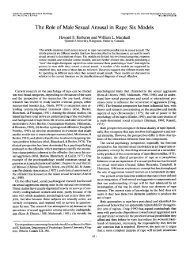Regulation of the dopamine transporter - Addiction Research ...
Regulation of the dopamine transporter - Addiction Research ...
Regulation of the dopamine transporter - Addiction Research ...
Create successful ePaper yourself
Turn your PDF publications into a flip-book with our unique Google optimized e-Paper software.
DAT <strong>Regulation</strong> Schmitt & Reith<br />
treatment with <strong>the</strong> well-established serotonergic<br />
neurotoxin 5,7-dihydroxytryptamine (5,7-DHT).<br />
Hence, authors <strong>of</strong> <strong>the</strong>se early studies concluded<br />
that MDA-like drugs produce neurotoxic insult to<br />
serotonergic neurons and suggested that <strong>the</strong> magnitude<br />
and duration <strong>of</strong> <strong>the</strong> decline in SERT expression<br />
constitutes a method <strong>of</strong> quantifying <strong>the</strong><br />
extent <strong>of</strong> this damage. The reduction in SERT expression<br />
that occurs after MDMA administration<br />
is quantitatively similar to reductions caused by<br />
4-substituted amphetamines, such as 4-MA and<br />
PCA. 127,128 In light <strong>of</strong> <strong>the</strong> fact that membrane trafficking<br />
<strong>of</strong> monoamine <strong>transporter</strong> proteins is altered<br />
upon exposure to amphetaminergic substrates—<br />
and that such changes persist beyond <strong>the</strong> duration<br />
<strong>of</strong> acute drug exposure—<strong>the</strong> question is<br />
thus whe<strong>the</strong>r or not reductions in SERT expression<br />
represent mere changes in <strong>transporter</strong> trafficking<br />
and membrane distribution or true damage to<br />
serotonergic neuronal function. Evidence in support<br />
<strong>of</strong> both conclusions exists. Experiments by<br />
Wang et al. 125,129 showed that MDMA administration<br />
reduces radioligand binding to plasmalemmal<br />
SERTs in rats; but unlike <strong>the</strong> specific serotonergic<br />
toxin 5,7-DHT, it nei<strong>the</strong>r alters total SERT<br />
protein expression nor induces microglial activation.<br />
In contrast, <strong>the</strong> results <strong>of</strong> Xie et al. 122 —who<br />
used a different, more specific antibody for immunochemical<br />
detection <strong>of</strong> <strong>the</strong> SERT protein—<br />
do indicate substantial loss <strong>of</strong> SERT protein after<br />
treatment with ei<strong>the</strong>r 5,7-DHT or <strong>the</strong> serotonergic<br />
amphetamines MDMA, PCA, and fenfluramine,<br />
suggesting functional damage to serotonergic nerve<br />
terminals (Ref. 122, Figs. 8–10). However, some<br />
<strong>of</strong> <strong>the</strong> differences seen by <strong>the</strong>se two groups may<br />
be related to respective MDMA dosing regimens:<br />
22.5 mg/kg total MDMA (3 × 7.5 mg/kg, each 2 h<br />
apart) was given in <strong>the</strong> studies by Wang et al., 125,129<br />
whereas a total dose <strong>of</strong> 45 mg/kg (3 × 15 mg/kg,<br />
each 1.5 h apart) was used in <strong>the</strong> Xie et al.<br />
study. 122 Callaghan et al. compared <strong>the</strong> effects <strong>of</strong> repeated<br />
administration <strong>of</strong> ei<strong>the</strong>r MDMA or 4-MA on<br />
in vitro measures <strong>of</strong> neurodegeneration (such as<br />
plasmalemmal SERT binding) with in vivo assessment<br />
<strong>of</strong> 5-HT clearance by using real-time microamperometry.<br />
128 Here, <strong>the</strong> authors found that<br />
[ 3 H]cyanoimipramine binding to <strong>the</strong> SERT was<br />
significantly reduced 2 weeks after repeated administration<br />
<strong>of</strong> ei<strong>the</strong>r high-dose 4-MA or MDMA<br />
(15 mg/kg, twice daily for 4 days); however, clear-<br />
ance <strong>of</strong> locally applied 5-HT was reduced only in<br />
rats treated with a high dose <strong>of</strong> 4-MA. The observation<br />
that 5-HT clearance in vivo was unaltered by<br />
even a high-dose MDMA treatment regimen suggests<br />
that in vitro measures, such as plasmalemmal<br />
SERT radioligand binding, do not necessarily predict<br />
<strong>the</strong> functional state <strong>of</strong> serotonergic neurons in<br />
vivo. Moreover, <strong>the</strong>se findings highlight that <strong>the</strong> toxicity<br />
<strong>of</strong> substituted amphetamines can vary greatly<br />
depending upon <strong>the</strong>ir individual chemical structure.<br />
Here 4-MA appears to have a greater potential<br />
than MDMA to elicit toxicity in vivo. This finding<br />
is certainly consistent with epidemiological data, 130<br />
which show a high incidence <strong>of</strong> mortality after consumption<br />
<strong>of</strong> clandestine pressed pills containing 4-<br />
MA sold as “ecstasy.” By contrast, fatalities caused<br />
by consumption <strong>of</strong> moderate doses <strong>of</strong> unadulterated<br />
MDMA (as opposed to ecstasy pills) in <strong>the</strong> absence<br />
<strong>of</strong> o<strong>the</strong>r drugs are exceedingly rare.<br />
Paradoxically, localized direct administration <strong>of</strong><br />
MDMA in rats by in vivo reverse microdialysis—<br />
at concentrations equivalent to those attained after<br />
high-dose systemic administration—does not result<br />
in <strong>the</strong> typical indicators <strong>of</strong> serotonergic neurotoxicity,<br />
despite eliciting dramatically greater increases<br />
in extracellular monoamine levels. 131 Surprisingly,<br />
MDMA was demonstrated to exert neuroprotective<br />
effects in cultured rat fetal neurons, indicating that<br />
direct exposure to <strong>the</strong> chemical itself is not necessarily<br />
cytotoxic. 132 In addition, whereas systemically<br />
administered MDA and MDMA acutely increase<br />
<strong>the</strong> concentration <strong>of</strong> radical reactive oxygen<br />
species (ROS) and produce oxidative stress in <strong>the</strong><br />
brain, direct intracerebroventricular administration<br />
is devoid <strong>of</strong> such effects. 131,133<br />
The difference in toxicological pr<strong>of</strong>ile between<br />
direct microdialysis and systemic routes <strong>of</strong> administration<br />
suggests that much <strong>of</strong> <strong>the</strong> toxicity <strong>of</strong><br />
MDA and its N-alkylated cousins is <strong>the</strong> result <strong>of</strong><br />
metabolic transformation <strong>of</strong> parent compounds<br />
into more potent neurotoxins. 134 In humans,<br />
MDA and MDMA are largely metabolized via<br />
demethylenation by <strong>the</strong> hepatic CYP2D6 enzyme<br />
to <strong>the</strong> respective 3,4-dihydroxyamphetamine<br />
species (�-methyl<strong>dopamine</strong> and �,Ndimethyl<strong>dopamine</strong>).<br />
135 In recent years, several<br />
investigators have revealed that—much like<br />
<strong>dopamine</strong>—<strong>the</strong>se catechol species readily undergo<br />
oxidation to semiquinone and quinone species<br />
that can form neurotoxic thioe<strong>the</strong>r compounds<br />
330 Ann. N.Y. Acad. Sci. 1187 (2010) 316–340 c○ 2010 New York Academy <strong>of</strong> Sciences.










